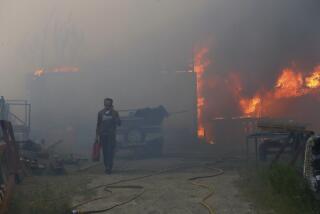Portugal Fears Reprise of the Big One
- Share via
LISBON — The roofless ruins of the 14th century Carmo Convent are an eerie sight.
The weather-bleached stone pillars and bare, soaring arches poke skyward like a skeleton, left as a monument to one of the strongest earthquakes to hit Western Europe.
The quake on All Saints’ Day 250 years ago reduced much of Lisbon to rubble. A tsunami and a six-day fire completed the devastation of what at the time was one of Europe’s biggest, finest cities. A fifth of Lisbon’s population is thought to have died, and 60,000 altogether in Portugal and North Africa.
The devastation contributed to Portugal’s slow decline as a world power and kindled a deep, pan-European debate about the nature of God.
“The 18th century used the word Lisbon much as we use the word Auschwitz today,” American philosopher Susan Neiman wrote in her 2002 book “Evil in Modern Thought.”
The Portuguese capital still feels the occasional minor tremor, and the threat of a repeat of Nov. 1, 1755, a magnitude 8 quake at the same junction of Atlantic tectonic plates, still hangs over the city. In recent weeks, spurred by last December’s Indian Ocean quake and tsunami, the city has been running ads on national TV featuring cartoon characters playing an “Earthquake Game” of do’s and don’ts.
But people in Lisbon have a fatalistic streak. “If it happens, it happens,” shrugged retiree Maria Fernandinha, shopping near the Carmo Convent. “It’s in God’s hands. What can we do about it?”
Lisbon is thought less vulnerable than Greece, Italy and Turkey, but quakes last century killed 30 people in southwestern Europe. “People should consider that, sooner or later, it will probably happen again,” says Joao Duarte Fonseca, a lecturer at Lisbon’s Superior Technical Institute.
He hopes that last year’s tsunami, this year’s India-Pakistan earthquake and the 250th anniversary of Lisbon’s disaster will crack the apathy.
But Fonseca, an expert on the 1755 quake, has a list of concerns: At least one-third of Lisbon’s buildings date from before seismic building codes were introduced in 1958; inspections are notoriously unreliable; there is no scientific map of treacherous geographical fault lines in mainland Portugal; Lisbon and its coastal suburbs are densely populated with 1.5 million people; and the public is untrained for emergencies.
“It’s an explosive mixture,” Fonseca says.
Historic inner-city districts draw tourists to their narrow, cobbled alleys, but these charming centuries-old attractions are potential death traps.
The city holds annual quake drills at only a handful of schools. The Indian Ocean disaster has revived talk of building a tsunami-alert system, but it would need European Union funding, and member states far from the vulnerable zone don’t want to share the cost, officials here say.
The National Firemen’s Assn. has expressed alarm that the urban emergency plans have not been tested on the ground.
The 18th century response set a high standard. Two food depots went up in the city center. All able-bodied men were mobilized to clear the streets and dump weighted-down bodies in the sea to head off disease. Looters were summarily tried and hanged. Profiteers were sentenced to four months of rowing galleons. Food taxes were waived.
All that in a matter of days. “You can’t help being impressed,” says Vitor Vieira, head of Lisbon City Council’s Civil Protection Service.
But some aftershocks could not be mitigated.
Portugal in the 18th century had an empire in Asia, Africa and Latin America, but the quake contributed to its gradual loss of international standing.
By raising questions about the nature of God and faith at a time when science and reason were challenging assumptions, the catastrophe also helped change 18th century European thought. The great thinkers of the time -- Goethe, Voltaire, Wesley, Kant -- weighed in on the fundamental mysteries: Why Lisbon, and why that date? Was it God’s punishment, or a random act of nature?
And what if it happens again?
Vieira describes the computer-simulated worst-case scenario: a repeat of the 1755 disaster -- 5,000 deaths, 50,000 homeless, 15% of buildings collapsed, 20% badly damaged, a huge tsunami within 20 minutes.
A city can never be fully prepared for catastrophe, Vieira says, pointing to New Orleans and the U.S. Federal Emergency Management Agency’s problems with Hurricane Katrina.
“We have learned a lot from the United States, especially the FEMA. Their response manuals are like a Bible for us,” he said.
“When I was watching Katrina I thought to myself: If they can’t cope, how could we?”
More to Read
Sign up for Essential California
The most important California stories and recommendations in your inbox every morning.
You may occasionally receive promotional content from the Los Angeles Times.













